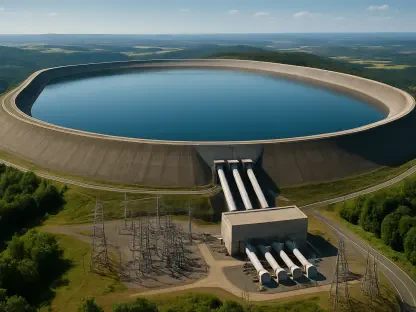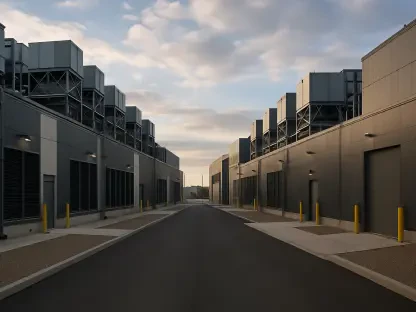The commencement of a substantial water treatment plant marks a pivotal moment for the Navajo-Gallup Water Supply Project, initiated by the U.S. Bureau of Reclamation. This ambitious project aims to address the critical water access issues experienced by the Navajo Nation and the City of Gallup. Essential to the effort are cultural elements, such as the Navajo blessing ceremony at the groundbreaking event, which underscore the project’s importance to local communities. A pivotal member of the endeavor, Bart Deming, a construction engineer with the Bureau’s Four Corners Construction Office, underscored that the water treatment plant represents the core component of the San Juan Lateral. It is envisioned to channel treated water from a designated reservoir to a multitude of homes.
Project Implementation and Progress
The Role of Jacobs Engineering and Funding Challenges
The water treatment plant, estimated at $267 million, has been contracted to Jacobs Engineering, which is responsible for both its design and construction. The anticipated completion date is set for the end of 2028. Concurrently, pipeline construction along with supplementary infrastructure will progress, signaling significant advancements in a project that was initially sanctioned in 2009. However, feasibility studies date back even further, to the 1970s. The total projected cost exceeds $2 billion, raising concerns about the necessity for additional Congressional funding to mitigate potential delays caused by supply chain disruptions and tariffs.
The continuous construction efforts reflect the scope and complexity of the Navajo-Gallup Water Supply Project. As the work advances, various elements must align to ensure timely progress. Careful coordination among federal agencies, contractors, and local entities is critical, especially considering the vast geographical area covered by the project. The timeline of construction activities from 2025 to 2028 thus emphasizes the strategic planning required to manage resources efficiently while addressing unforeseen challenges.
Addressing Water Supply Issues
More than 40% of households in the Navajo Nation currently rely on hauling water due to a lack of infrastructure. Meanwhile, Gallup is experiencing significant groundwater depletion, exacerbating the city’s already critical water supply issues. This project is defined by the San Juan and Cutter laterals. The San Juan Lateral is poised to provide a sustainable water source, while the Cutter Lateral has already been serving communities since 2020. The project leverages multiple funding streams, including the Indian Water Rights Settlement Completion Fund, the bipartisan infrastructure law, the Reclamation Water Settlement Fund, and authorization under the Northwestern New Mexico Rural Water Projects Act.
While addressing the water supply issues remains central to the project’s objectives, the benefits extend beyond immediate relief. Reliable access to water can catalyze economic development, improve public health, and foster community resilience in the face of environmental changes. The multifaceted approach of integrating various funding mechanisms ensures financial stability, supporting the long-term vision of the project. This strategic planning is paramount to achieving sustainable outcomes and meeting the diverse needs of the affected populations.
Cultural and Community Impact
Significance of the Navajo Blessing Ceremony
The groundbreaking event’s inclusion of a Navajo blessing ceremony signals the deep cultural and community significance of the Navajo-Gallup Water Supply Project. The ceremony embodies the values and traditions of the Navajo people, emphasizing the project’s commitment to respecting and integrating cultural practices. The blend of modern engineering solutions with traditional ceremonies highlights the collaborative effort to honor indigenous heritage while addressing contemporary challenges.
Recognizing the cultural impact of the project is crucial to its acceptance and success within the local communities. By valuing traditional practices, the project fosters a sense of ownership and engagement among the Navajo Nation. This approach promotes mutual understanding and strengthens partnerships, ensuring that the development aligns with the aspirations and values of the local population.
Developing Opportunities for the Navajo Nation and Gallup
Bart Deming, speaking for the Bureau’s Four Corners Construction Office, indicated that beyond providing clean drinking water, the Navajo-Gallup Water Supply Project is expected to foster new development opportunities. This milestone highlights the remarkable progress with the project at approximately 70% completion. Despite the ongoing challenges, advancing this reliable water infrastructure not only secures essential resources but also opens pathways for growth and development in the Navajo Nation and the City of Gallup.
The impact of the project on local development can be profound. Improvements in water access can lead to enhanced agricultural productivity, better health outcomes, and increased educational opportunities. For Gallup, securing a stable water source is vital to overcoming the limitations imposed by groundwater depletion. The project’s comprehensive planning and execution demonstrate an aligned effort combining federal support and local needs, thereby optimizing water security and setting a foundation for a prosperous future.
Future Considerations and Long-Term Success
Navigating Ongoing Challenges
As the Navajo-Gallup Water Supply Project continues to progress, navigating the ongoing challenges remains crucial to its success. Supply chain disruptions and tariffs have already posed potential obstacles, stressing the importance of additional Congressional funding and strategic planning. The need for consistent funding allocation and support to ensure timely completion underscores the complexities inherent in such large-scale infrastructure projects.
Effective risk management and contingency planning are essential to address these challenges. Proactive measures, including securing alternative supply chains and negotiating tariff exemptions, can mitigate risks and maintain momentum. Emphasizing flexibility and adaptability within project management frameworks ensures that unforeseen issues are promptly and efficiently handled, safeguarding the project’s timeline and objectives.
Ensuring Sustainable Outcomes
Achieving sustainable outcomes is central to the project’s long-term success. The Navajo-Gallup Water Supply Project exemplifies a comprehensive approach to water security, integrating cultural significance, community development, and modern engineering solutions. This holistic strategy is designed not only to alleviate immediate water scarcity but to foster a resilient and thriving community.
Continued collaboration among federal agencies, local entities, and indigenous communities is vital to sustaining the project’s achievements. Ensuring that the infrastructure remains robust and adaptable to changing circumstances and future demands is imperative. Continuous evaluation and maintenance of the water treatment systems will sustain their effectiveness and reliability, nurturing a legacy of sustainability and growth for the Navajo Nation and Gallup.
Conclusion: Path Forward for Water Security
The launch of a significant water treatment facility signifies a crucial development for the Navajo-Gallup Water Supply Project, initiated by the U.S. Bureau of Reclamation. This sizeable project aims to resolve the pressing water accessibility issues faced by the Navajo Nation and the City of Gallup. Integral to this initiative are cultural aspects, such as the Navajo blessing ceremony held at the groundbreaking event, emphasizing the project’s significance to local communities. A key participant, Bart Deming, a construction engineer with the Bureau’s Four Corners Construction Office, emphasized that the water treatment facility is the central element of the San Juan Lateral. It is planned to convey treated water from a specific reservoir to numerous households. The wider project not only promises improved water access but also represents a bonding moment that respects and incorporates Navajo traditions and cultural heritage. This blend of modern engineering and cultural respect sets a precedent for future infrastructure endeavors in indigenous communities.









